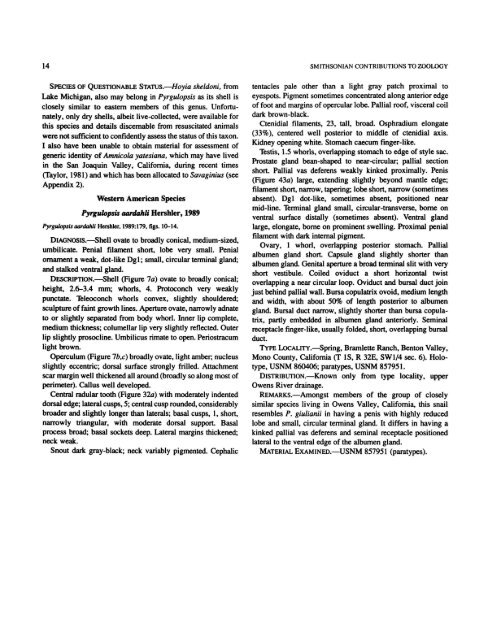A Review of the North American Freshwater Snail Genus Pyrgulopsis
A Review of the North American Freshwater Snail Genus Pyrgulopsis
A Review of the North American Freshwater Snail Genus Pyrgulopsis
You also want an ePaper? Increase the reach of your titles
YUMPU automatically turns print PDFs into web optimized ePapers that Google loves.
14 SMITHSONIAN CONTRIBUTIONS TO ZOOLOGY<br />
SPECIES OF QUESTIONABLE STATUS.—Hoyia sheldoni, from<br />
Lake Michigan, also may belong in <strong>Pyrgulopsis</strong> as its shell is<br />
closely similar to eastern members <strong>of</strong> this genus. Unfortunately,<br />
only dry shells, albeit live-collected, were available for<br />
this species and details discernable from resuscitated animals<br />
were not sufficient to confidently assess <strong>the</strong> status <strong>of</strong> this taxon.<br />
I also have been unable to obtain material for assessment <strong>of</strong><br />
generic identity <strong>of</strong> Amnicola yatesiana, which may have lived<br />
in <strong>the</strong> San Joaquin Valley, California, during recent times<br />
(Taylor, 1981) and which has been allocated to Savaginius (see<br />
Appendix 2).<br />
Western <strong>American</strong> Species<br />
<strong>Pyrgulopsis</strong> aardahli Hershler, 1989<br />
<strong>Pyrgulopsis</strong> aardahli Hershler, 1989:179, figs. 10-14.<br />
DIAGNOSIS.—Shell ovate to broadly conical, medium-sized,<br />
umbilicate. Penial filament short, lobe very small. Penial<br />
ornament a weak, dot-like Dgl; small, circular terminal gland;<br />
and stalked ventral gland.<br />
DESCRIPTION.—Shell (Figure la) ovate to broadly conical;<br />
height, 2.6-3.4 mm; whorls, 4. Protoconch very weakly<br />
punctate. Teleoconch whorls convex, slightly shouldered;<br />
sculpture <strong>of</strong> faint growth lines. Aperture ovate, narrowly adnate<br />
to or slightly separated from body whorl. Inner lip complete,<br />
medium thickness; columellar lip very slightly reflected. Outer<br />
lip slightly prosocline. Umbilicus rimate to open. Periostracum<br />
light brown.<br />
Operculum (Figure lb,c) broadly ovate, light amber; nucleus<br />
slightly eccentric; dorsal surface strongly frilled. Attachment<br />
scar margin well thickened all around (broadly so along most <strong>of</strong><br />
perimeter). Callus well developed.<br />
Central radular tooth (Figure 32a) with moderately indented<br />
dorsal edge; lateral cusps, S; central cusp rounded, considerably<br />
broader and slightly longer than laterals; basal cusps, 1, short,<br />
narrowly triangular, with moderate dorsal support. Basal<br />
process broad; basal sockets deep. Lateral margins thickened;<br />
neck weak.<br />
Snout dark gray-black; neck variably pigmented. Cephalic<br />
tentacles pale o<strong>the</strong>r than a light gray patch proximal to<br />
eyespots. Pigment sometimes concentrated along anterior edge<br />
<strong>of</strong> foot and margins <strong>of</strong> opercular lobe. Pallial ro<strong>of</strong>, visceral coil<br />
dark brown-black.<br />
Ctenidial filaments, 23, tall, broad. Osphradium elongate<br />
(33%), centered well posterior to middle <strong>of</strong> ctenidial axis.<br />
Kidney opening white. Stomach caecum finger-like.<br />
Testis, 1.5 whorls, overlapping stomach to edge <strong>of</strong> style sac.<br />
Prostate gland bean-shaped to near-circular, pallial section<br />
short. Pallial vas deferens weakly kinked proximally. Penis<br />
(Figure 43a) large, extending slightly beyond mantle edge;<br />
filament short, narrow, tapering; lobe short, narrow (sometimes<br />
absent). Dgl dot-like, sometimes absent, positioned near<br />
mid-line. Terminal gland small, circular-transverse, borne on<br />
ventral surface distally (sometimes absent). Ventral gland<br />
large, elongate, borne on prominent swelling. Proximal penial<br />
filament with dark internal pigment.<br />
Ovary, 1 whorl, overlapping posterior stomach. Pallial<br />
albumen gland short. Capsule gland slightly shorter than<br />
albumen gland. Genital aperture a broad terminal slit with very<br />
short vestibule. Coiled oviduct a short horizontal twist<br />
overlapping a near circular loop. Oviduct and bursal duct join<br />
just behind pallial wall. Bursa copulatrix ovoid, medium length<br />
and width, with about 50% <strong>of</strong> length posterior to albumen<br />
gland. Bursal duct narrow, slightly shorter than bursa copulatrix,<br />
partly embedded in albumen gland anteriorly. Seminal<br />
receptacle finger-like, usually folded, short, overlapping bursal<br />
duct.<br />
TYPE LOCALITY.—Spring, Bramlette Ranch, Benton Valley,<br />
Mono County, California (T IS, R 32E, SW1/4 sec. 6). Holotype,<br />
USNM 860406; paratypes, USNM 857951.<br />
DISTRIBUTION.—Known only from type locality, upper<br />
Owens River drainage.<br />
REMARKS.—Amongst members <strong>of</strong> <strong>the</strong> group <strong>of</strong> closely<br />
similar species living in Owens Valley, California, this snail<br />
resembles P. giulianii in having a penis with highly reduced<br />
lobe and small, circular terminal gland. It differs in having a<br />
kinked pallial vas deferens and seminal receptacle positioned<br />
lateral to <strong>the</strong> ventral edge <strong>of</strong> <strong>the</strong> albumen gland.<br />
MATERIAL EXAMINED.—USNM 857951 (paratypes).

















